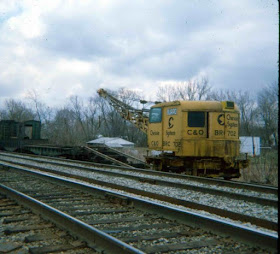NorthAmericanInterlockings: photo photo
Chicago and Northern Indiana Railroad Interlocking Towers (click the marker for more information)
 |
| Scott Griffith posted [This picture is from the 1915 Smoke Abatement Report.] |
 |
| Mark Hinsdale posted Mark Bilecki Sr. Nice catch near Hick tower [Note the pipes on the left and a couple of bridges in the up position at the Indiana Harbor Canal.] |
 |
| Joseph Tuch Santucci posted Caught this westbound on the Chicago Line passing Hick Tower in the Indiana Harbor area of East Chicago, IN during the summer of 1996. |
 |
| Viral Media posted East Chicago Interlocking Hick Tower controls the NS lift bridge that is choke point for Chicalo Line traffic traffic. All NS Chicago Line traffic has to the cross the double track lift bridge. There are six lift bridges at this location but only three bridges remain in operation: CLIFF’s (ArcelorMittal) blue bridge, the former EJ&E (CN) Scherzer and the Norfolk Southern (NYC) Chicago Line bridge. The remaining bridges are “in the upright and locked position” (non-operable). |
Joseph Tuch Santucci posted four photos with the comment: "We’ve been outside of Hick, here now is the inside. Hick was an incredibly busy place. At least, but usually more than seventy Conrail and Amtrak moves daily, Conrail moves to and from IHB’s Kankakee Line daily, the B&O trackage rights movements, Chicago Short Line trackage rights moves, the traffic on the EJ&E Lakefront line, the IHB moves across and onto and from the Chicago Line plus IHB trackage rights moves on the EJ&E. Well the traffic as of the time period I captured these photos inside the tower during 1993."
Daniel Kopack: The board is still there, as is the paper holder on the desk, itself still there, one of the legs is worn to almost the thickness of a pencil...the "Low speed" was taken out of service Jan 6 1994..two weeks before I started posting there..
 |
| 1 |
 |
| 2 |
 |
| 3 |
 |
| 4 |
John Ryan provided four pictures in and around this tower with the comment:
(new window)
This is where and when I started. Notice the B&O (CSX) tracks are in and the B&O Bridge is down.
The first picture is a chart for Rings For So. Chicago Line. This was use for communication with the EJ&E. I don't recall ever having to use this.
 |
| 1 |
 |
| 2 |
 |
| 3 |
 |
| 4 |
 |
| Bryan Monaco posted Hick tower and the abandoned NYC (LSMS) bridge in East Chicago, Indiana. The bridges cross the Indiana Harbor Canal. As spotted from Amtrak's Lake Shore Limited. Wolverine Services go by here too. Evan Manley Hick is still an active tower. Unless you are just talking about just the bridge and not both. Bryan Monaco I've read it's closed. Bryan Monaco That's good to know because it been widely reported, on some railfan blogs, as closed. Matt McClure Bryan Monaco Nope. Open and active. I was there last weekend and it was raised with a tender who came out to watch the bridge. Matt McClure The full complement of bridges from south to north: ex-NYC pipeline bridge (out of service), ex-NYC main bridge (out of service), ex-NYC Chicago Line bridge (active), B&O passenger line bridge (Lake sub, out of service) and EJ&E Lakefront Branch bridge(active and recently replaced--the bright blue bridge!) The NYC's three bridges were for the connection to the Egyptian Line for the far south bridge and the middle two NYC bridges were for the long-time four-track main. Dennis DeBruler I read that the blue bridge was built by Arcelor Mittal to connect the two steel mills that they bought. The south-most NYC bridge providing a longer connector to the Egyptian Line answers a question that has been on my mind for years. Dennis DeBruler How fast does the Wolverine run through here? Buying an Amtrak ticket to New Buffalo, MI, to get photos of these bridges, a coaling tower, and maybe even some steel mills might be worth it. https://www.google.com/.../data=!3m2!1e3!4b1!4m5!3m4...If it runs past these bridges at 70mph, that would not be very many photos. But if it creeps across that bridge, then it might be feasible to get some photos of those bridges. Some of them have a Rall design, which is quite rare. Bryan Monaco It doesn't go particularly fast through this area. Dennis DeBruler Thanks. That is what I suspected. |
 |
| Ken Schmidt posted
The suggestion of Hick Tower brought back memories of sitting at the East Chicago Amtrak 'shed' and watching things go by.
We did venture to the west side of the canal, and captured this image of the J going east in September of 1991.
The backdrop of the blast furnaces in Plant 4 of Inland Steel gave the look of heavy industries which made the region what it was.
|
 |
| HalstEd Pazdzior posted Chicago Short Line doing some work around whiting. 5/23/22 |
 |
| Dennis DeBruler commented on HalstEd's post https://www.google.com/.../data=!3m6!1e1!3m4... |
















































